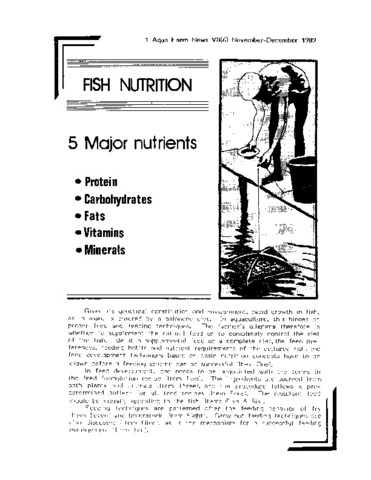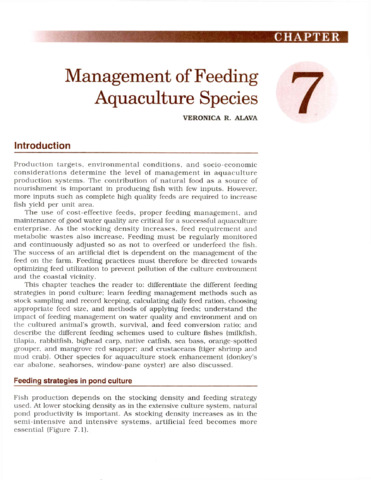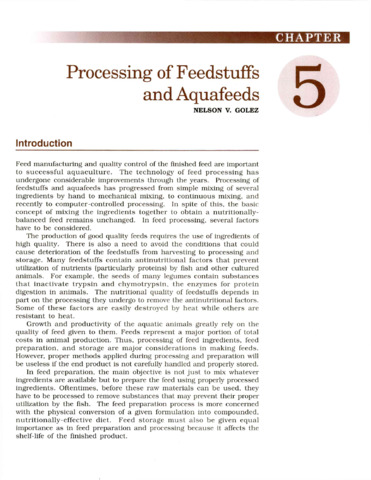| dc.contributor.author | Eusebio, Perla S. | |
| dc.contributor.author | Coloso, Relicardo M. | |
| dc.contributor.author | Mamauag, Roger Edward | |
| dc.contributor.editor | Rimmer, Michael A. | |
| dc.contributor.editor | McBride, Shannon | |
| dc.contributor.editor | Williams, Kevin C. | |
| dc.date.accessioned | 2015-10-14T00:56:02Z | |
| dc.date.available | 2015-10-14T00:56:02Z | |
| dc.date.issued | 2004 | |
| dc.identifier.citation | Eusebio, P. S., Coloso, R. M., & Mamauag, R. E. P. (2004). Evaluation of some terrestrial proteins in complete diets for grouper (Epinephelus coioides) juveniles. In M. A. Rimmer, S. McBride, & K. C. Williams (Eds.), Advances in grouper aquaculture (pp. 79–84). Canberra: Australian Centre for International Agricultural Research. | en |
| dc.identifier.isbn | 9781863204385 | |
| dc.identifier.uri | http://hdl.handle.net/10862/2414 | |
| dc.description.abstract | This study was undertaken to determine the nutritive value of some of the more widely available protein sources in the diets for grouper juveniles, based on apparent digestibility coefficients for dry matter (ADMD) and crude protein (APD), feed conversion ratio (FCR), specific growth rate (SGR) and survival. A series of feeding experiments were conducted to determine the growth performance of grouper juveniles. Test diets were formulated for growth (4 replications/treatment) and digestibility experiments (3 replications/treatment). Each diet contained a test ingredient: white fish meal, white cowpea meal and ipil-ipil leaf meal (experiment 1); local meat and bone meal, soya protein concentrates and meat solubles (experiment 2); and imported meal and bone meal, blood meal and maize gluten meal (experiment 3). A feeding trial for each experiment was conducted for 85 days in a flow-through system with filtered and aerated seawater. 10 and 20 juveniles were stocked in each of 60- and 250-litre fibreglass tanks, respectively. White cowpea meal (20.5% incorporation), local (16% incorporation) and imported (19% incorporation) meat and bone meals could partially replace fish meal in the diets for grouper juveniles without affecting their growth. Low ADMD and APD values for the processed feed ingredients (meat and bone meal, soya protein concentrates and blood meal-based diets) could be associated with the processing methods used in its preparation, which could damage the amino acids and contribute to low nitrogen digestibility. Apparent digestibility coefficients and growth could be used as indicators of the nutritional value of the feed ingredients. However, the availability and optimal balance of amino acids must also be considered. | en |
| dc.language.iso | en | en |
| dc.publisher | Australian Centre for International Agricultural Research | en |
| dc.subject | Leucaena leucocephala | en |
| dc.subject | Epinephelus coioides | en |
| dc.subject | groupers | en |
| dc.title | Evaluation of some terrestrial proteins in complete diets for grouper (Epinephelus coioides) juveniles | en |
| dc.type | Book chapter | en |
| dc.citation.spage | 79 | |
| dc.citation.epage | 84 | |
| dc.subject.asfa | animal nutrition | en |
| dc.subject.asfa | feed conversion efficiency | en |
| dc.subject.asfa | growth rate | en |
| dc.subject.asfa | diet | en |
| dc.subject.asfa | nutritive value | en |
| dc.subject.asfa | proteins | en |
| dc.subject.asfa | feeding experiments | en |
| dc.subject.asfa | fishmeal | en |
| dc.subject.asfa | digestibility | en |
| dc.subject.asfa | feed composition | en |
| dc.citation.bookTitle | Advances in grouper aquaculture | en |



